Tarnów-Lesser Poland 作者: 来源: 发布时间:2021-05-20
Ⅰ. Population and Area
Population (31 December 2019)
• City 108,470 Decrease (35th)
Area
• City 72.4 km2 (28.0 sq mi)
Website
http://www.tarnow.pl
Ⅱ.Natural Geography
Tarnów lies at the Carpathian foothills, on the Dunajec and the Biała rivers. The area of the city is 72.4 square kilometres (28.0 sq mi). It is divided into sixteen districts, known in Polish as osiedla. A few kilometers west of the city lies the district of Mościce, built in the late 1920s, together with a large chemical plant. The district was named after President of Poland, Ignacy Mościcki.
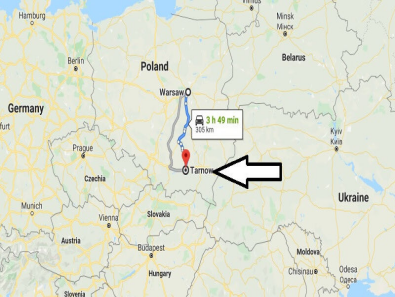
Transport
Tarnów is an important road and rail hub. It lies at the intersection of two major roads – the A4-PL.svg motorway along European route E40, and the National Road nr. 73, which goes from Kielce to Jasło. Furthermore, the city is a rail junction, with four lines: three main electrified routes (westward to Kraków, eastward to Dębica and southward to Nowy Sącz), as well as secondary-importance local connection to Szczucin. The history of rail transport in Tarnów dates back to the year 1856, when the Galician Railway of Archduke Charles Louis reached the city. The architectural complex of Tarnów Main Station, fashioned after the Lviv railway station was completed in 1906 by the Austrian Partition. Since 2010, Tarnów station houses a gallery of modern art, the only such gallery located in a rail station in Poland. Tarnów also has three additional stations: Tarnów Mościce, as well as Tarnów Północny and Tarnów Klikowa, both of which are currently out of service.
The city's public transport system consists of 29 municipal bus routes, which provide convenient transportation to all districts. In 1911–1942 Tarnów had a tram line, with the length of 2.5 kilometres, since replaced by buses
Ⅲ.Economy
Unemployment in the city of Tarnów (rate in%)
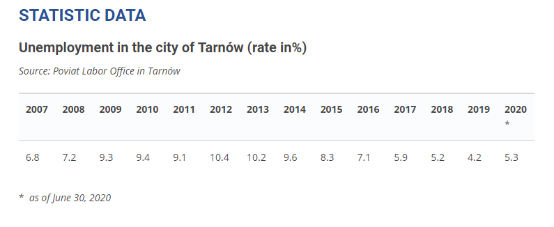
Number of business entities by PKD section in the city of Tarnów
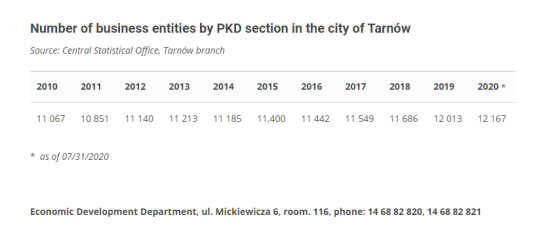
-TARNÓW IN NUMBERS
-Tarnów is a perfectly connected, compact center, offering low investment costs and access to specialized staff.
-After nearly 700 years from granting city rights, Tarnów is still an important economic center with a population of almost 110,000. residents.
-The falling unemployment rate in Tarnów was estimated at 5.1% in October 2018.
-The constantly growing number of economic entities amounts to approx. 12,062, of which the largest group are micro-enterprises, constituting as much as 94% of all companies.
-An important advantage is the human potential, which is the result of a wide educational offer that meets the needs of the labor market.
-Over 5,300 students study at 5 universities, which enable young people from all over the region to acquire knowledge.
-There are also 7 business support institutions in Tarnów.
-Dane statystyczne - TARNÓW - Polski Biegun Ciepła https://tarnow.pl/Dla-firm-i-inwestorow/Biznes-w-Tarnowie/Dane-statystyczne
Ⅳ.Industrial Characteristics
Defence industry and chemical industry and gas center
Tarnów is an important center of economy and industry. The city has chemical plants including Zakłady Azotowe w Tarnowie-Mościcach S.A., which is part of Poland's biggest company operating within the chemical sector Grupa Azoty, Becker Farby Przemysłowe Sp. z o.o., Summit Packaging Polska Sp. z o.o.; as well as food plants (Fritar), building materials (Leier Polska S.A., Bruk-Bet), textiles (Spółdzielnia "Tarnowska Odzież, Tarnospin, Tarkonfex"), and several warehouses, as well as a distribution center of the Lidl supermarket chain. Tarnów is an important center of natural gas industry, with headquarters of three different gas corporations.
Another significant company based in Tarnów is the Zakłady Mechaniczne Tarnów operating in the defence industry. It manufactures handguns, assault rifles, sniper rifles and anti-air guns. It is part of the state-controlled Bumar Corporation.
Among the major shopping malls in Tarnów are the Gemini Park Tarnów and Galeria Tarnovia.
Key Programs,
1. PROGRAM "LOCAL DEVELOPMENT"
-I invite all of you to submit ideas for projects for the municipal project, which will be submitted to the "Local Development" Program, co-financed by the Norwegian Financial Mechanism and the European Economic Area.
-The submitted ideas of projects, both of an investment nature and of a "soft" nature, could be financed from the above Program and implemented in our city. Thanks to our joint activity, both individual residents and organized environments, we will be able to introduce a new quality to many areas of our life and the immediate surroundings.
-Program "Local Development" - TARNÓW - Polish Heat Run https://tarnow.pl/Miasto/Rozwoj/Program-Rozwoj-Lokalny
2. EUROPEAN PROJECTS
-REMOTE SCHOOL PLUS - SUPPORT FOR THE POLISH NATIONAL EDUCATIONAL NETWORK IN THE REMOTE EDUCATION SYSTEM
-The Commune of the City of Tarnów is implementing the project co-financed by European funds. The Commune of the City of Tarnów is implementing the project "Remote school plus - support for the National Educational Network in the remote education system", co-financed by European funds.
-European projects - TARNÓW - Polish Heat Pole https://tarnow.pl/Miasto/Rozwoj/Projekty-europejskie
Ⅴ.Attrations and Cityscape

Polish Gothic-styled Cathedral of the Nativity located in the Old Town district
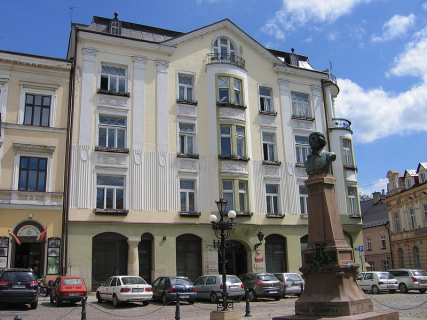
Casimir the Great Square
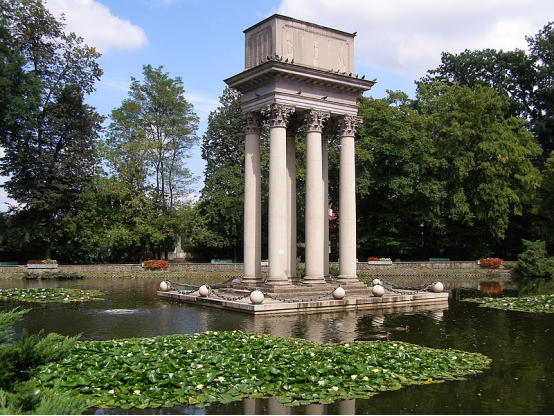
Tomb of General Józef Bem, national hero of Poland, Hungary and the former Ottoman Empire
Tarnow is an important tourist, cultural and economic center in Lesser Poland Voivodeship. The old town of Tarnow, called the "pearl of the Polish Renaissance", is one of the most beautiful examples of the Renaissance architectural layout of Polish cities.
Points of interest around the city include:
Market Square in the Old Town, with the medieval urban layout of streets and tenement houses, some from the Renaissance period,
Roman Catholic churches, such as the Tarnów Cathedral (14th century, renovated in 1889–1900), and Holy Trinity church (16th century).
Ⅵ.History and Culture
The first documented mention of the settlement dates back to 1105, spelled as Tharnow. The name later evolved to Tarnowo (1229), Tarnów (1327), and Tharnow (1473).[4] The place name Tarnów is widely used in different forms across Slavic Europe, and lands which used to be inhabited by Slavs, such as eastern Germany, Hungary, and northern Greece. There is a German town, Tarnow, Greek Tyrnavos (also spelled as Tirnovo), Czech Trnov, Bulgarian Veliko Tarnovo and Malko Tarnovo, as well as different Trnovos/Trnowos in Slovenia, Slovakia, Serbia, Bosnia, and North Macedonia. The name Tarnów comes from an early Slavic word trn/tarn, which means "thorn", or an area covered by thorny plants.
History
Polish Gothic-styled Cathedral of the Nativity located in the Old Town district
Casimir the Great Square
Already in the mid-9th century, on the Tarnów's St. Martin Mount (Góra sw. Marcina, 2.5 kilometers from the centre of today's city), a Slavic gord was established, probably by the Vistulans. Due to efforts of local archaeologists, we know that the size of the gord was almost 16 hectares, and it was surrounded by a rampart. The settlement was probably destroyed in the 1030s or the 1050s, during either a popular rebellion against Christianity (see Baptism of Poland), or Czech invasion of Lesser Poland. In the mid-11th century, a new gord was established on the Biała river. It was a royal property, which in the late 11th or early 12th century was handed over to the Tyniec Benedictine Abbey. The name Tarnów, with a different spelling, was for the first time mentioned in a document of Papal legate, Cardinal Gilles de Paris (1124).
The first documented mention of Tarnów occurs in the year 1309, when a list of miracles of Kinga of Poland specifies a woman named Marta, who was resident of the settlement. In 1327, a knight named Spicymir (Leliwa coat of arms) purchased a village of Tarnów Wielki, and three years later, founded his own private town. On 7 March 1330, King Władysław I the Elbow-high granted Magdeburg rights to Tarnów. In the same year, construction of a castle on the St. Martin Hill was completed by Castellan of Kraków, Spycimir Leliwita of Leliwa coat of arms (its ruins can still be seen).
Tarnów remained in the hands of the Leliwa family, out of which in the 15th century the Tarnowski family emerged. In the 14th century, numerous German settlers immigrated from Kraków and Nowy Sącz (see Walddeutsche, Ostsiedlung). During the 17th century Scottish immigrants began to come in large numbers. In 1528 the exiled King of Hungary János Szapolyai lived in the town. The town prospered during the Polish Golden Age, when it belonged to Hetman Jan Tarnowski (1488–1561). In the mid-16th century, its population was app. 1,200, with 200 houses located within town's defensive wall (the wall itself had been built in the mid-15th century, and expanded in the early 16th century). In 1467, the waterworks and sewage systems were completed, with large cisterns filled with drinking water built in the main market square. In the 16th century, during the period known as the Polish Golden Age, Tarnów had a school, a synagogue, a Calvinist prayer house, Roman Catholic churches, and up to twelve guilds.
Polish–Lithuanian Commonwealth
Tarnów Cathedral preserved one of the most extraordinary examples of renaissance and mannerist tomb monuments in the country. After the death of Jan Tarnowski (16 May 1561), Italian sculptor Jan Maria Padovano began creating one of the most beautiful examples of Renaissance headstones in the Polish–Lithuanian Commonwealth. The monument of hetman Tarnowski is almost 14 meters tall, and stands in St. Anne Chapel, which is located in northern nave of the Tarnów Cathedral. Padovano completed his work in 1573; furthermore, he designed the Renaissance town hall, and oversaw its remodelling in the 1560s. At that time, in 28 niches of the town hall were portraits of members of the Tarnowski family – from Spicymir Leliwita to Jan Krzysztof Tarnowski, who died in 1567. In 1570 Tarnów became property of the Ostrogski family, after Zofia Tarnowska, the daughter of the hetman, married prince Konstanty Wasyl Ostrogski. In 1588, after Konstanty's death, the town changed hands several times, belonging to different families, which slowed its development. Until the Partitions of Poland, Tarnów belonged to the County of Pilzno, Sandomierz Voivodeship. The town, like almost all locations of Lesser Poland, was devastated in October 1655, during the Swedish invasion of Poland, and as a result, its population declined from 2,000 to 768. In 1723, the town became the property of the Sanguszko family, which purchased it from the Lubomirski family.
Habsburg Empire
Tomb of General Józef Bem, national hero of Poland, Hungary and the former Ottoman Empire
After the first partition of Poland (1772), Tarnów was annexed by the Habsburg Empire, and remained in Austrian Galicia until late 1918. Austrian rule initially brought positive changes, as the town ceased to be private property, became the seat of a county (German: kreis), and of the Roman Catholic Diocese of Tarnów (1783). On 14 March 1794, Józef Bem was born in Tarnów. In the 1830s, under the influence of events in Congress Poland (see November Uprising), Tarnów emerged as a center of Polish conspiratorial organizations. Plans for a national uprising in Galicia failed in early 1846, when local peasants began murdering the nobility in the Galician slaughter. The massacre, led by Jakub Szela (born in Smarżowa), began on 18 February 1846. Szela's peasant units surrounded and attacked manor houses and settlements located in three counties – Sanok, Jasło, and Tarnów. The revolt got out of hand and the Austrians had to put it down.
Tarnów went through the period of quick development in the second half of the 19th century, due to the program of construction of the railway system. In 1852, the town received rail connection with Kraków, due to the Galician Railway of Archduke Charles Louis, and in 1870, its population was 21,779. In 1878, gas lighting was introduced, and three years later, the first daily newspaper appeared. In 1888, the Diocese Museum was founded by Rev. Jozef Baba, and in 1910, Tarnów received modern waterworks, a power plant and a new complex of the main rail station. The city remained a hotspot of Polish conspirational activities, with up to 20% of all members of the Polish Legions in World War I coming from Tarnów and its area. On 10 November 1914, units of the Russian Imperial Army captured Tarnów, and remained in the city until 6 May 1915 (see Gorlice–Tarnów Offensive). In the early stages of the offensive, Tarnów was shelled by German-Austrian heavy artillery, which brought destruction to some of its districts.
Market Square with historic and colourful tenements
Second Polish Republic
Tarnów was one of the first Polish cities to be freed during the rebirth of Poland following World War I. The Polish Legions liberated the city on the night of 30–31 October 1918. In the Second Polish Republic, Tarnów belonged to Kraków Voivodeship, and gave the newly established country many outstanding figures, such as Franciszek Latinik and Wincenty Witos. In early 1927, construction of a large chemical plant was initiated in the suburban village of Świerczków Świerczków [pl], which is now a part of the industrial borough of Mościce, a district of the city. Before the outbreak of World War II, the population of Tarnów was 40,000, of which almost half were Jewish.
1939 invasion of Poland
First transport of Polish captives deported from Tarnów to Auschwitz concentration camp during German AB-Aktion in Poland, June 1940
On 28 August 1939, a Nazi saboteur conducted the Tarnów rail station bomb attack killing 20 civilians, two days before the invasion of Poland by Nazi Germany. The city was overrun by the German forces on 7 September 1939. Tarnów was incorporated into the General Government territory as the seat of the Kreishauptmanschaft Tarnow district on 26 October 1939.
On 14 June 1940, the first mass transport left the Tarnów station to Auschwitz concentration camp, with 728 Polish political prisoners. All throughout the German occupation of Poland Tarnów was an important center of the Armia Krajowa (AK) and other resistance organizations. In the mid-1944, AK's 16th Infantry Regiment "Barbara" took part in Operation Tempest. The Wehrmacht retreated from Tarnów on 18 January 1945, and the city was captured by the Red Army.
Ludwik Solski Theatre
A few months later, the Museum of Tarnów Land was opened, and Tarnów began a postwar recovery. In 1957, State Theatre of Ludwik Solski was opened, and in 1975 Tarnów became the capital of a voivodeship.
The Jews of Tarnów
Before World War II, about 25,000 Jews lived in Tarnów. Jews, whose recorded presence in the town went back to the mid-15th century, comprised about half of the town's total population. A large portion of Jewish business in Tarnów was devoted to garment and hat manufacturing. The Jewish community was ideologically diverse and included religious Hasidim, secular Zionists, and many more.
Immediately following the German occupation of the city on 8 September 1939, the persecution of the Jews began. German units burned down most of the city's synagogues on 9 September and drafted Jews for forced-labor projects. Tarnów was incorporated into the Generalgouvernement. Many Tarnów Jews fled to the east, while a large influx of refugees from elsewhere in occupied Poland continued to increase the town's Jewish population. In early November, the Germans ordered the establishment of a Jewish council (Judenrat) to transmit orders and regulations to the Jewish community. Among the duties of the Jewish council were enforcement of special taxation on the community and providing workers for forced labor.
During 1941, life for the Jews of Tarnów became increasingly precarious. The Germans imposed a large collective fine on the community. Jews were required to hand in their valuables. Roundups for labor became more frequent and killings became more commonplace and arbitrary. Deportations from Tarnów began in June 1942, when about 13,500 Jews were sent to the Belzec extermination camp. The first major act in the extermination of the Jews of Tarnów was the so-called "first operation" from 11–19 June 1942. The Germans gathered thousands of Jews in the Rynek (market place), and then they were tortured and killed. During this time period, on the streets of the town and in the Jewish cemetery, about 3,000 Jews were shot; in the woods of Zbylitowska Góra a few kilometers away from Tarnów a further 7,000 were murdered.According to a document from Michal Borawski born in 1926, featured at the entry of the Bimah as part of the panel offered by the Batorego Foundation, the street stairs ("małe schody" or little stairs) from the town-center to the Bernardynski street (where the Bernardine Monastery is located), had to be cleaned of the blood by the local fire brigade for three days.
Existing remains of the old synagogue
After the June deportations, the Germans forced the surviving Jews of Tarnów, along with thousands of Jews from neighboring towns, into the new Tarnów Ghetto. The ghetto was surrounded by a high wooden fence. Living conditions in the ghetto were deplorable, marked by severe food shortages, a lack of sanitary facilities, and a forced-labor regimen in factories and workshops producing goods for the German war industry. In September 1942, the Germans ordered all ghetto residents to report to Targowica Square, where they were subjected to a 'selection' in which those deemed 'non-essential' were singled out for deportation to Belzec. About 8,000 people were deported. Thereafter, deportations from Tarnów to extermination camps continued sporadically; the Germans deported a group of 2,500 in November 1942.
Holocaust resistance
In the midst of the 1942 deportations, some Jews in Tarnów organized a Jewish resistance movement. Many of the resistance leaders were young Zionists involved in the Hashomer Hatzair youth movement. Many of those who left the ghetto to join the partisans fighting in the forests later fell in battle with SS units. Other resisters sought to establish escape routes to Hungary, but with limited success. The Germans decided to destroy the Tarnów ghetto in September 1943. The surviving 10,000 Jews were deported, 7,000 of them to Auschwitz and 3,000 to the Plaszow concentration camp in Kraków. In late 1943, Tarnów was declared "free of Jews" (Judenrein). By the end of the war, the overwhelming majority of Tarnów Jews had been murdered by the Germans. Although 700 Jews returned in 1945, some of them soon left the city. Many moved to Israel.
Ⅶ.Other Information
The first documented mention of the settlement dates back to 1105, spelled as Tharnow. The name later evolved to Tarnowo (1229), Tarnów (1327), and Tharnow (1473). The place name Tarnów is widely used in different forms across Slavic Europe, and lands which used to be inhabited by Slavs, such as eastern Germany, Hungary, and northern Greece. There is a German town, Tarnow, Greek Tyrnavos (also spelled as Tirnovo), Czech Trnov, Bulgarian Veliko Tarnovo and Malko Tarnovo, as well as different Trnovos/Trnowos in Slovenia, Slovakia, Serbia, Bosnia, and North Macedonia. The name Tarnów comes from an early Slavic word trn/tarn, which means "thorn", or an area covered by thorny plants.
Ⅷ.Contact Information
-Mayor Roman Ciepiela (PO)
-Tarnów City Hall ul. Mickiewicza 233-100 Tarnów
-Tel (14) 688 24 00
-umt@umt.tarnow.pl
